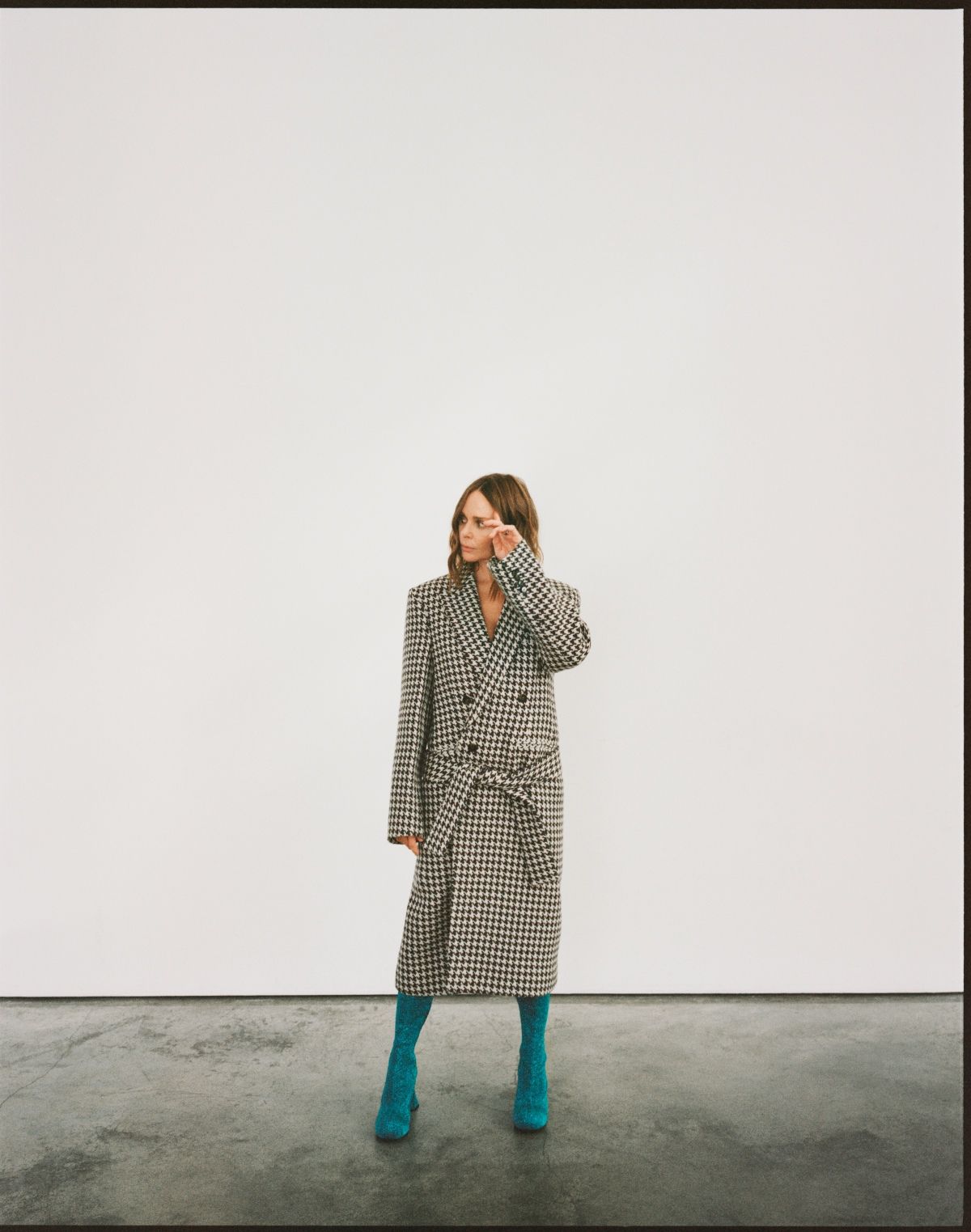
The future is always at hand when you spend time in the presence of Stella McCartney. During our last encounter, circa 2017, she was championing the fact her company had spent three years researching, investing in and developing a more sustainable substitute for viscose, one of fashion’s most widely used materials, made from trees (more than 100 million trees a year are cut down for viscose’s sake.) McCartney also spoke at that time about converting ocean waste into textiles and clothing. She had enacted a limited-edition Falabella Go backpack comprising recycled polyester fabric and made of Parley Ocean Plastic, using a 100 percent regenerated Econyl yarn.
“Design and business have to come together and be more forward-thinking,” she propheted. Little did we know at the time she was simultaneously examining strategies for conjuring a leather substitute, not least because for one whose commitment to “eco-futures” is so unrelentingly progressive and pioneering, she was being screwed on the bottom line. “I get charged 30 percent more for bringing a non-leather product into America than the original,” she flabbergasted, hands in the air.
Fast forward to today, and McCartney’s beaming and bristling with inimitable eco-punk vigour and vim given the reality of her new “leather alternative” Mylo, derived from mushrooms, with which she’s producing bags and clothing, and even a leather alternative sourced from discarded grapes in Italian wineries, for her autumn/winter ’22 collections. It’s an apex moment of discovery on the sustainable, nay, regenerative environmental trail she’s blazed for the last 21 years.
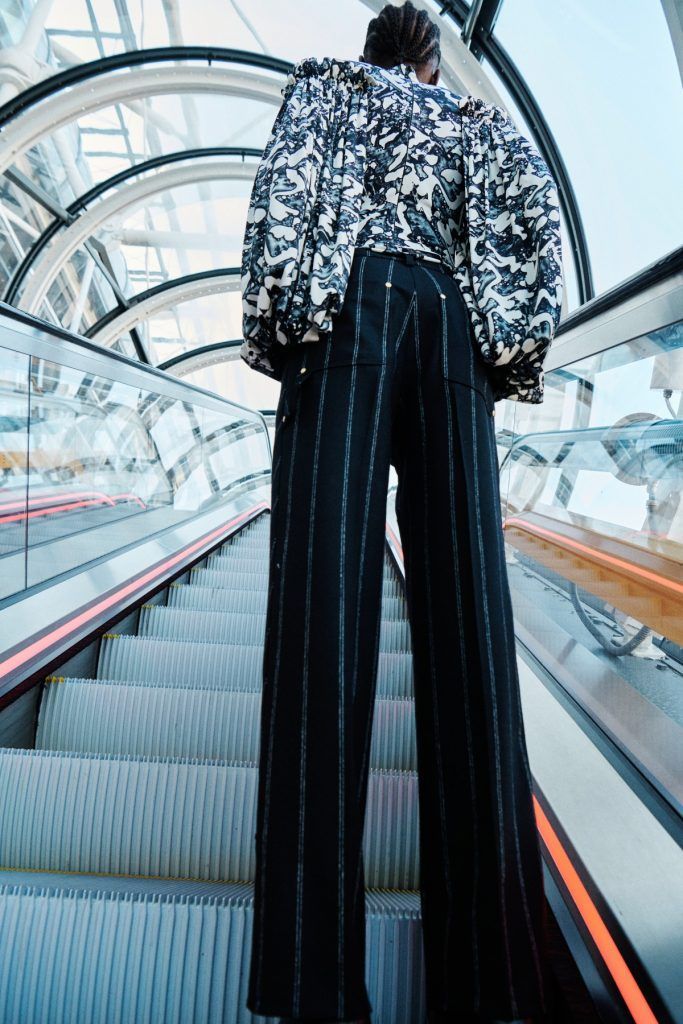
“All innovations take time, energy and investment,” she reminds us, “to work with companies to develop something that’s ready for market. That’s a part of the process I still find exhilarating.” A smile speaks across her face. How ironic. It’s also the part that explains why more luxury brands haven’t committed to similar, or in most cases any, action – the detrimental impact on the bottom line, which in turn stifles their vision and suffocates necessary technological innovation.
Undeterred, McCartney goes full-on Stellavision; a woman three decades into helming her own brand sets down her stall and reaffirms the mantra. “You can’t lose sight of the goal. You have to maintain hope. As a company, we do all the groundwork because we believe we can change the course of the industry if we support and grow these innovations, and make them more accessible for other brands.” And Mylo is such a moment.
Consider the mushroom, which right now is fashion’s immediate future – and, quite likely, humanity’s. Fungi are everywhere. They exist under the earth, on top of our skin and inside our bodies. Their spores float around us constantly. The total number of fungal species on Earth, according to the Royal Botanic Gardens in Kew, London, is between 2.2 and 3.8 million. And yet – at a time when we’re programming artificial intelligence to run our future worlds – 93 percent of those millions of fungal species are currently unknown to us. What was it Socrates famously declared? “I am the wisest man alive, for I know one thing, and that is that I know nothing.”

We’ve come to realise that mushrooms – far more complex than we ever knew – are Nature’s supercomputers, communicating through their hyphae like our neural networks. Recent scientific study and DNA testing has substantiated that fungi aren’t even plants, but closer to animals. And there are two types; one that breaks down organic matter and another that carries water. The fleshy entities we call mushrooms are the “fruiting” bodies of the mycelium, a thread-like fungal network of hyphae that exists beneath it. Mycelium can hold up to 30,000 times its weight, bind soil together and communicate information between trees, hence the “Wood Wide Web”. Humans, plants, animals and bacteria live in symbiosis with mushrooms; the roots of plants, from trees to food crops, are intertwined with fungi that are fundamental in providing nutrients and water to vegetation. Without fungi, plants might never have colonised land at all.
In March 2021, Paris Jackson, daughter of late pop colossus Michael Jackson, posted a short video to her Instagram (@parisjackson), in which she was the first person seen wearing Mylo fabric: “Hey, I’m Paris Jackson, and I’m wearing the world’s first-ever garments made from Mylo, an animal-free vegan leather created from mushrooms. These pieces were designed by my friend Stella McCartney, who is the Queen of Sustainable Fashion and Innovation. More than one billion animals die for fashion every year and animal agriculture is making climate change worse. That’s why Mylo is not only better for the future of fashion, but the future of our planet.”
We are the world. It’s marketspeak, and canny at that, but it’s also reminder that Stella McCartney has been pretty much “first” in everything she purveys. And the hits keep on coming, ahem, a trait that appears to run in the family. “How can you not be obsessed with fantastic fungi?,” triumphs Stella. “If we want to save all our skins from the consequences of the climate and biodiversity crises, we need to stop fashion’s use of animal leather and furs. Mushrooms present a vegan alternative that can be grown regeneratively, renewably and quickly.”
McCartney’s mycological moment spawned during a visit to the Bolt Threads (@boltthreads) start-up tech-and-textiles firm in California, and its founder and CEO Dan Widmaier. He told McCartney the answers to fashion’s materials problems were already available in nature and that fashion could henceforward take on a regenerative silhouette. Transfixed, McCartney invested on the spot and helped research, develop and pioneer a Bolt Threads product called Mylo_Unleather, @mylo_unleather (tagline: all of the leather, none of the animal), with which she produced the Frayme Mylo in July, the world’s first mycelium luxury bag.
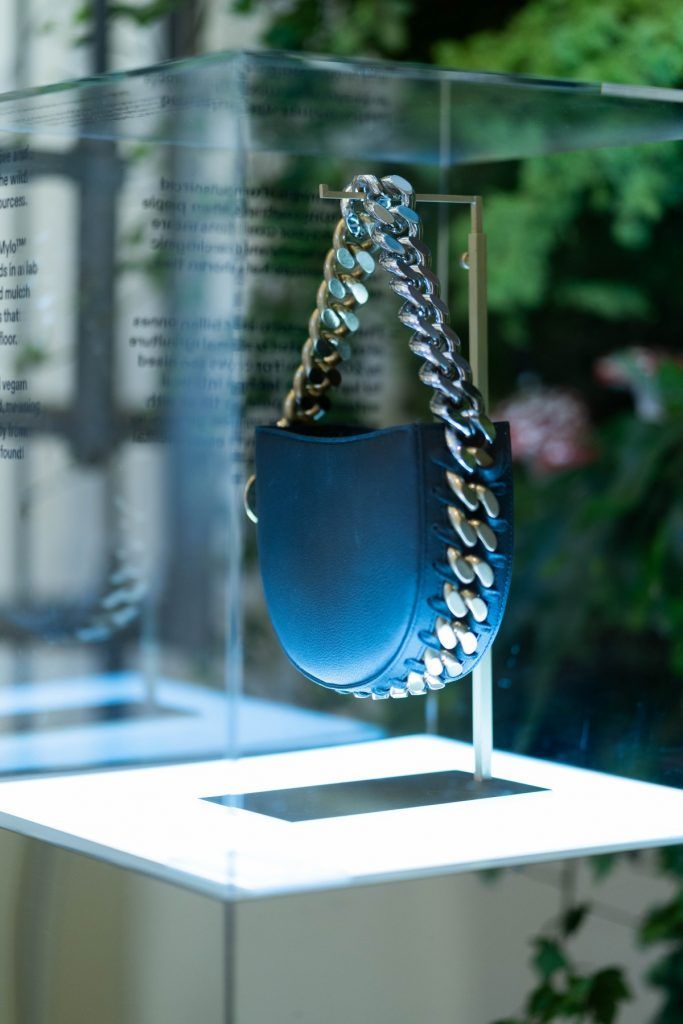
McCartney posted her own Frayme Mylo bag on Instagram (@stellamccartney) on July 29, with no small sense of provenance: “This is a moment in fashion history – the world’s first-ever luxury bag crafted from mycelium. Thank you for being part of our conscious luxury movement.” The message is triumphant, and yet … one senses the subliminal defiance, the anarchic gesture of two-fingered mindfulness towards a latent luxury business she tires of lecturing and leading from the front. And in appropriately Stellabratory style, McCartney not only changes the raw materials, but shifts the cultural and stylistic syntax – “conscious luxury”. Because McCartney’s journey has taken her – and us – from buzzwords like environment, to sustainable, to regenerative and now “conscious luxury”. The planet’s eco-awareness in fashion is the summation of her storytelling. “I barely even know what the word sustainable means any more”, she dismisses, as though it’s almost last-century thinking.
Widmaier, also the author of TedTalk “The Future of Fashion – Made from Mushrooms”, thinks McCartney has reached fashion’s next-gen nirvana. “We’re making fashion regenerative with science – and we’re doing it not by changing the humans but by changing the materials themselves.” He cites the Frayme Mylo bag as the tipping point. “It’s the first proof that the future of fashion, can and will be made with sustainable, regenerative materials.”
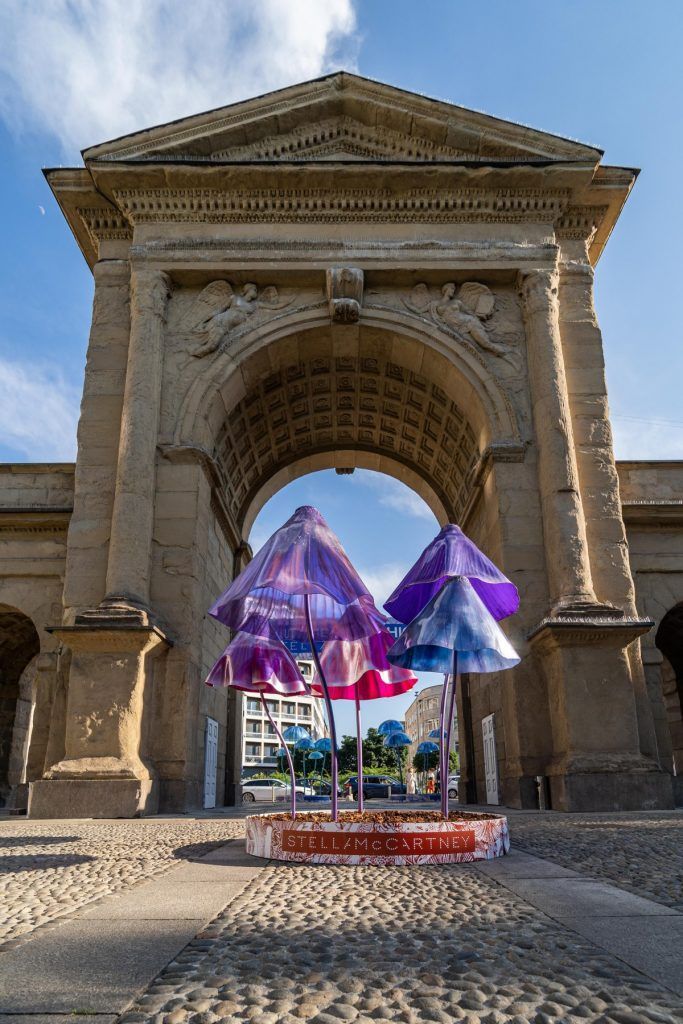
The superlative speak around mycelium’s new materialism belies the substantial grunt work that’s gone into its creation. McCartney explains the reality of roughly six years and countless rounds of prototyping to reach a stage where mycelium material “looks and feels like real animal leather. It’s soft, supple and hardwearing like real leather and obviously less harmful to the environment.” And, most importantly, she almost has a product she can “scale”: since 2020, the brand Stella McCartney has become part of the Mylo consortium, which includes Adidas, Lululemon and Kering.
How then does McCartney view potential alternatives to mycelium (’shroom for manoeuvre anyone?), which she herself is helping to create with “grape leather” bags for winter ’22. “It’s incredible,” she enthuses. “You’d never be able to tell the bags are made from grapes, they’re so realistic.” And then another first. “We’re using this grape leather for our new family of bags called the S Wave that I cannot wait to champion!” It drops this month.
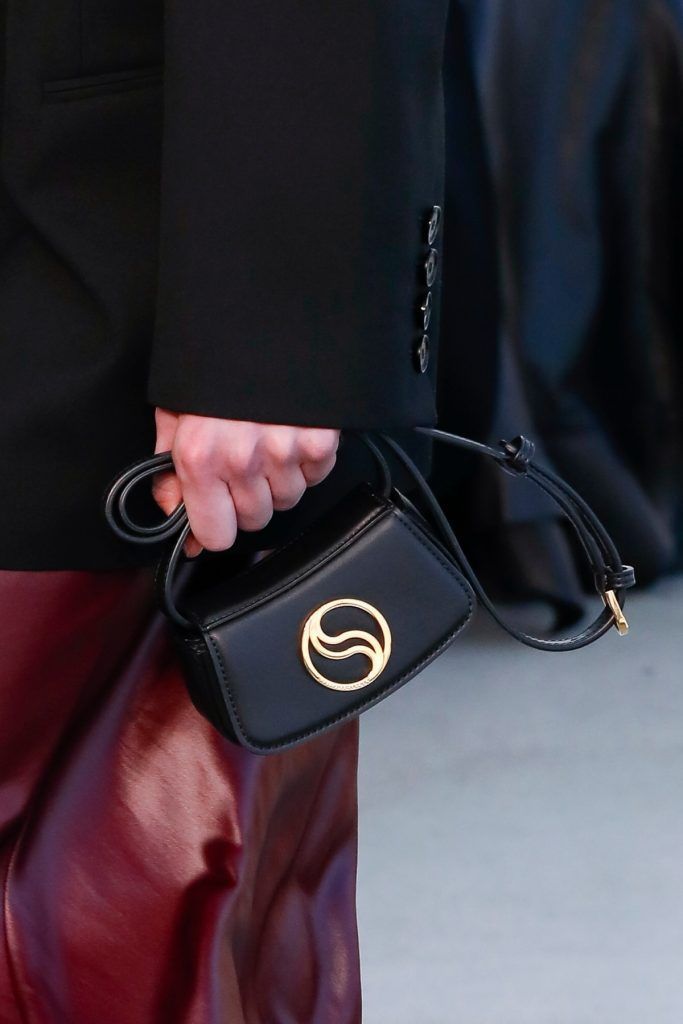
Meantime, while there are advances in plant-based leather alternatives, “from apple, to cactus, to grape leather”, McCartney considers mycelium something of a Holy Grail. “It’s a great leather alternative because of its XX-factor properties,” she declares. “After several years, we’ve learned to produce Mylo in a way that feels more substantial and elevated compared to other animal leather alternatives.” She goes on to explain that Mylo is harvested as a foamy layer and mimics the microstructure of collagen, giving the final material a warmth and sponginess not possible in synthetic options.” And, most vital of all. “Mycelium is regenerative; it thrives abundantly in the wild feeding on natural resources.”
Time is up. And the future’s here already. There’s still so much we haven’t discussed; like China expansion – McCartney just opened a Shanghai Qiantan store in July, with pending openings in Taiyuan, Qingdao and Haikou (she has two in Hong Kong). Oh, and the vibey-est forthcoming fashion/art collaboration collection in November/December, which much as she wants to discuss, she can’t yet. And her Frank Stella-inspired autumn/winter collection. And Adidas and sportswear advancements. One wonders, given the breadth of McCartney’s mission, whether there’s anything else she especially wants to share.
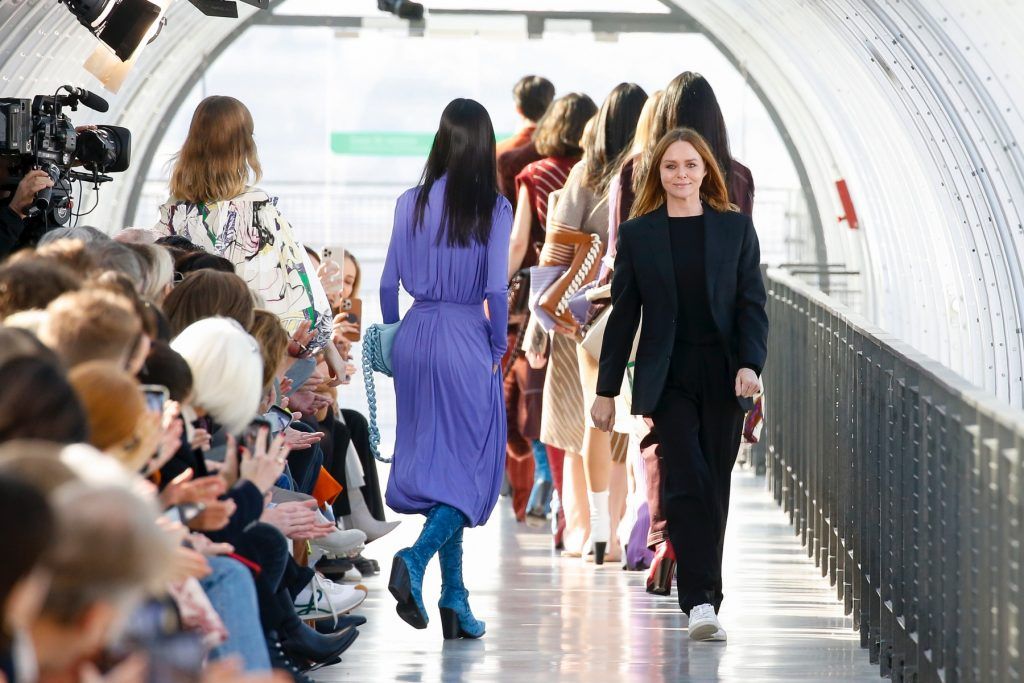
“Ultimately, we were the first luxury brand with sustainability at its heart,” she reminds us. “We saw the need for regenerative agriculture, sustainable design and the need to become a change agent from the outset.” And while the fashion cognoscenti were more immediately interested in her hemline lengths on catwalks, McCartney was attuned to a very different jingle. “We could already sense the problems of limited resources, with how we consume, manufacture and source materials.”
McCartney’s way more than iconic: she’s a singular category all her own – “econic”. “And yes. Today, 2022, is an incredibly exciting time to be working in fashion, because it feels like there’s a lot of great stuff bubbling. We’re on the verge of becoming scalable.”
As she speaks this line, you feel an urge to want to vote for her; for the stellarious punk/activist vibe she riffs and rants and raves off, with all her Stellebrity attachments – Paris, Taylor Swift, Grimes and more; for her stellabratory achievements in tech, textile, science, R&D; and, not least, her stellavisionary purpose. For if today’s fashion students can graduate into “incredibly exciting times”, they do so cognisant and conscious that McCartney has single-handedly scaled and abled it so.
(Header image: Stella McCartney photographed by Gabby Laurent)
This story first appeared on PrestigeOnline Hong Kong

